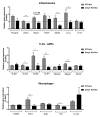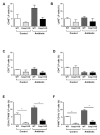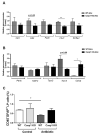Inflammasome Signaling Regulates the Microbial-Neuroimmune Axis and Visceral Pain in Mice
- PMID: 34361102
- PMCID: PMC8371481
- DOI: 10.3390/ijms22158336
Inflammasome Signaling Regulates the Microbial-Neuroimmune Axis and Visceral Pain in Mice
Abstract
Interactions between the intestinal microbiota, immune system and nervous system are essential for homeostasis in the gut. Inflammasomes contribute to innate immunity and brain-gut interactions, but their role in microbiota-neuro-immune interactions is not clear. Therefore, we investigated the effect of the inflammasome on visceral pain and local and systemic neuroimmune responses after antibiotic-induced changes to the microbiota. Wild-type (WT) and caspase-1/11 deficient (Casp1 KO) mice were orally treated for 2 weeks with an antibiotic cocktail (Abx, Bacitracin A and Neomycin), followed by quantification of representative fecal commensals (by qPCR), cecal short chain fatty acids (by HPLC), pathways implicated in the gut-neuro-immune axis (by RT-qPCR, immunofluorescence staining, and flow cytometry) in addition to capsaicin-induced visceral pain responses. Abx-treatment in WT-mice resulted in an increase in colonic macrophages, central neuro-immune interactions, colonic inflammasome and nociceptive receptor gene expression and a reduction in capsaicin-induced visceral pain. In contrast, these responses were attenuated in Abx-treated Casp1 KO mice. Collectively, the data indicate an important role for the inflammasome pathway in functional and inflammatory gastrointestinal conditions where pain and alterations in microbiota composition are prominent.
Keywords: gut commensal microbiota; gut–brain axis; immune system; inflammasome.
Conflict of interest statement
FS is the co-founder/shareholder of Alimentary Health Ltd., Tucana Health Ltd. and Atlantia Food Clinical Trials Ltd. and scientific advisor to Kaleido Biosciences. All other authors declare no conflict of interest. The funders had no role in the design of the study; in the collection, analyses, or interpretation of data; in the writing of the manuscript, or in the decision to publish the results.
Figures






Similar articles
-
Stress and antibiotics alter luminal and wall-adhered microbiota and enhance the local expression of visceral sensory-related systems in mice.Neurogastroenterol Motil. 2013 Aug;25(8):e515-29. doi: 10.1111/nmo.12154. Epub 2013 May 27. Neurogastroenterol Motil. 2013. PMID: 23711047
-
Antibiotic-induced dysbiosis alters host-bacterial interactions and leads to colonic sensory and motor changes in mice.Gut Microbes. 2015;6(1):10-23. doi: 10.4161/19490976.2014.990790. Epub 2015 Jan 20. Gut Microbes. 2015. PMID: 25531553 Free PMC article.
-
Inflammasome signaling affects anxiety- and depressive-like behavior and gut microbiome composition.Mol Psychiatry. 2016 Jun;21(6):797-805. doi: 10.1038/mp.2016.46. Epub 2016 Apr 19. Mol Psychiatry. 2016. PMID: 27090302 Free PMC article.
-
The Gut-Brain Axis: How Microbiota and Host Inflammasome Influence Brain Physiology and Pathology.Front Immunol. 2020 Dec 10;11:604179. doi: 10.3389/fimmu.2020.604179. eCollection 2020. Front Immunol. 2020. PMID: 33362788 Free PMC article. Review.
-
Microbiota-gut-brain axis in health and disease: Is NLRP3 inflammasome at the crossroads of microbiota-gut-brain communications?Prog Neurobiol. 2020 Aug;191:101806. doi: 10.1016/j.pneurobio.2020.101806. Epub 2020 May 28. Prog Neurobiol. 2020. PMID: 32473843 Review.
Cited by
-
The interplay between the microbiota and opioid in the treatment of neuropathic pain.Front Microbiol. 2024 Jun 10;15:1390046. doi: 10.3389/fmicb.2024.1390046. eCollection 2024. Front Microbiol. 2024. PMID: 38919504 Free PMC article. Review.
-
Gut microbiota modulates visceral sensitivity through calcitonin gene-related peptide (CGRP) production.Gut Microbes. 2023 Jan-Dec;15(1):2188874. doi: 10.1080/19490976.2023.2188874. Gut Microbes. 2023. PMID: 36939195 Free PMC article.
-
An IBD-associated pathobiont synergises with NSAID to promote colitis which is blocked by NLRP3 inflammasome and Caspase-8 inhibitors.Gut Microbes. 2023 Jan-Dec;15(1):2163838. doi: 10.1080/19490976.2022.2163838. Gut Microbes. 2023. PMID: 36656595 Free PMC article.
-
The impact of the microbiota-gut-brain axis on endometriosis-associated symptoms: mechanisms and opportunities for personalised management strategies.Reprod Fertil. 2024 May 1;5(2):e230085. doi: 10.1530/RAF-23-0085. Online ahead of print. Reprod Fertil. 2024. PMID: 38739749 Free PMC article.
-
Gut microbiota dysbiosis alters chronic pain behaviors in a humanized transgenic mouse model of sickle cell disease.Pain. 2024 Feb 1;165(2):423-439. doi: 10.1097/j.pain.0000000000003034. Epub 2023 Sep 21. Pain. 2024. PMID: 37733476 Free PMC article.
References
MeSH terms
Substances
Grants and funding
LinkOut - more resources
Full Text Sources
Research Materials

